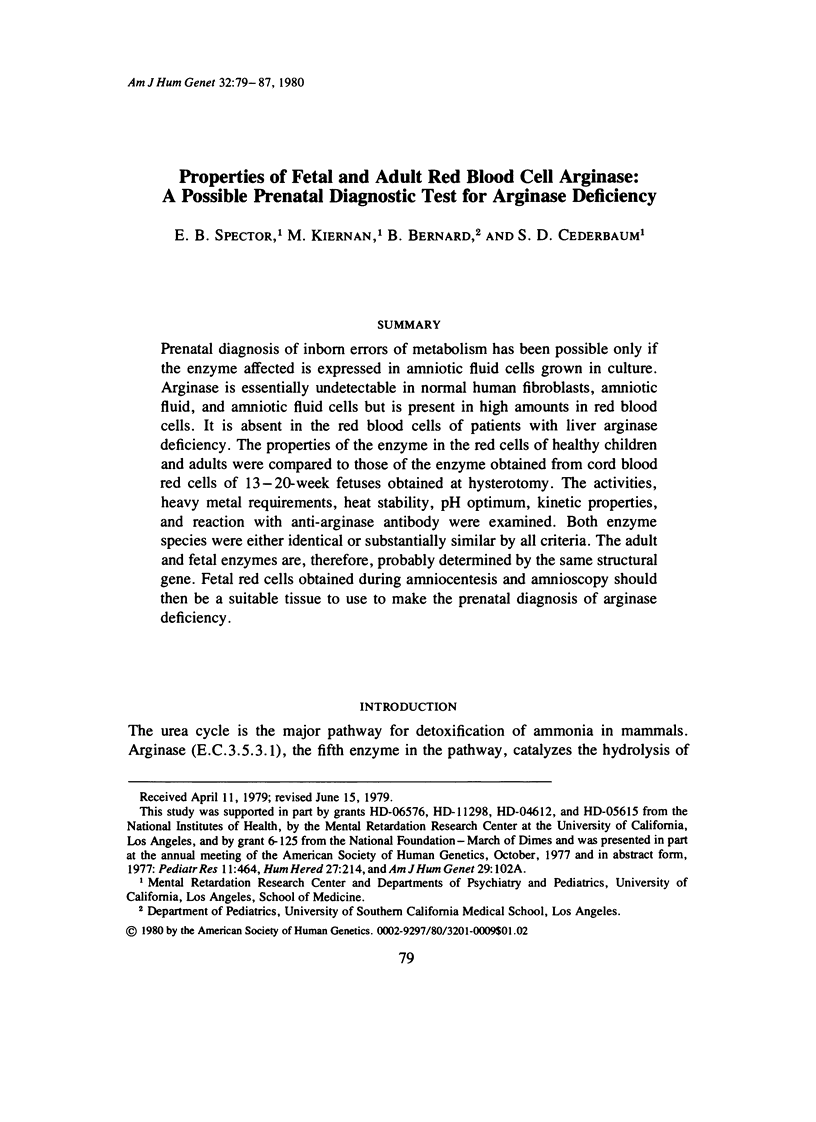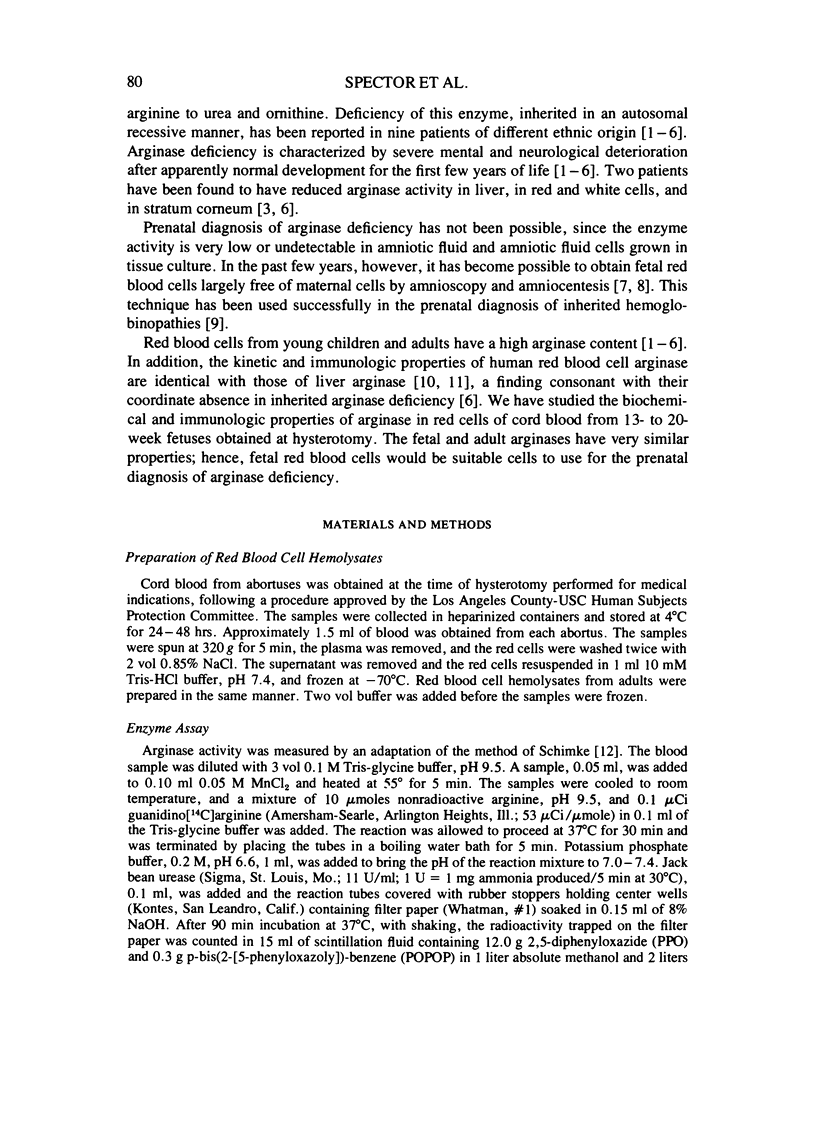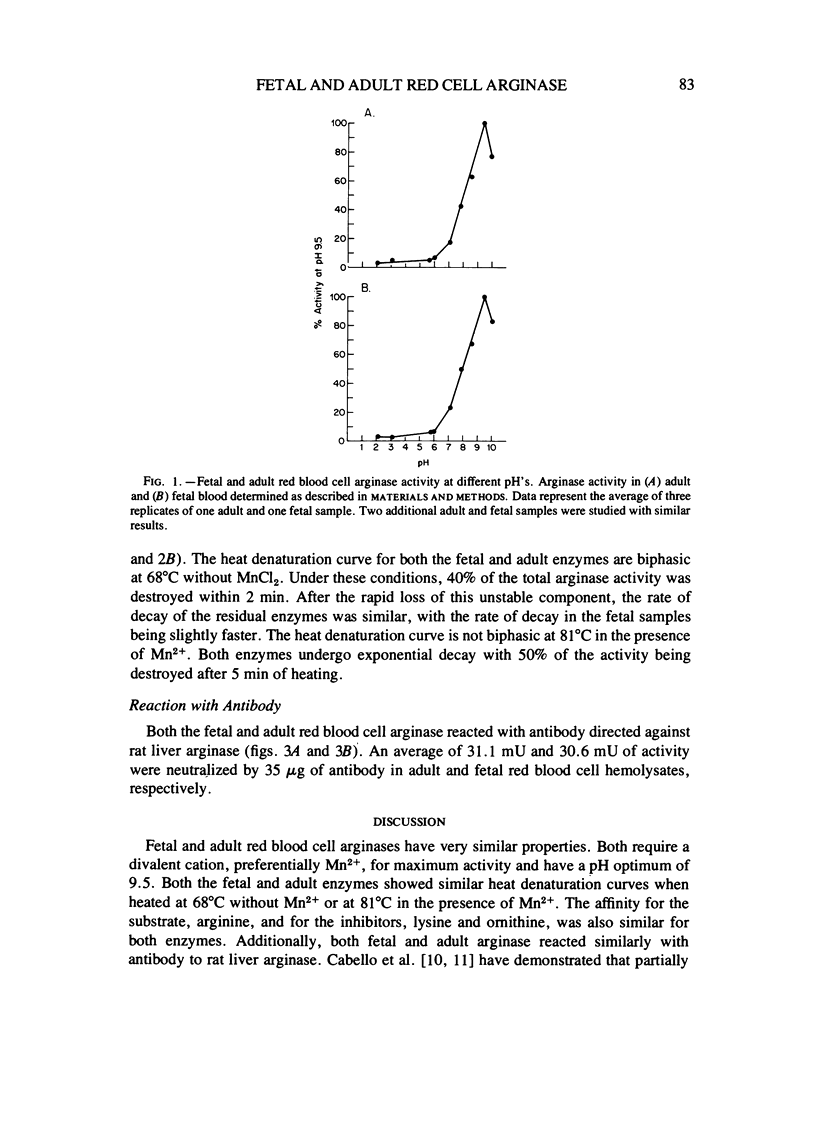Abstract
Prenatal diagnosis of inborn errors of metabolism has been possible only if the enzyme affected is expressed in amniotic fluid cells grown in culture. Arginase is essentially undetectable in normal human fibroblasts, amniotic fluid, and amniotic fluid cells but is present in high amounts in red blood cells. It is absent in the red blood cells of patients with liver arginase deficiency. The properties of the enzyme in the red cells of healthy children and adults were compared to those of the enzyme obtained from cord blood red cells of 13--20-week fetuses obtained at hysterotomy. The activities, heavy metal requirements, heat stability, pH optimum, kinetic properties, and reaction with anti-arginase antibody were examined. Both enzyme species were either identical or substantially similar by all criteria. The adult and fetal enzymes are, therefore, probably determined by the same structural gene. Fetal red cells obtained during amniocentesis and amnioscopy should then be a suitable tissue to use to make the prenatal diagnosis of arginase deficiency.
Full text
PDF








Selected References
These references are in PubMed. This may not be the complete list of references from this article.
- Alter B. P., Modell C. B., Fairweather D., Hobbins J. C., Mahoney M. J., Frigoletto F. D., Sherman A. S., Nathan D. G. Prenatal diagnosis of hemoglobinopathies. A review of 15 cases. N Engl J Med. 1976 Dec 23;295(26):1437–1443. doi: 10.1056/NEJM197612232952601. [DOI] [PubMed] [Google Scholar]
- Alter B. P., Nathan D. G. Antenatal diagnosis of haematological disorders--'1978'. Clin Haematol. 1978 Feb;7(1):195–216. [PubMed] [Google Scholar]
- Boyer S. H., Noyes A. N., Boyer M. L. Enrichment of erythrocytes of fetal origin from adult-fetal blood mixtures via selective hemolysis of adult blood cells: an aid to antenatal diagnosis of hemoglobinopathies. Blood. 1976 Jun;47(6):883–897. [PubMed] [Google Scholar]
- CABELLO J., BASILIO C., PRAJOUX V. Kinetic properties of erythrocyte- and liver arginase. Biochim Biophys Acta. 1961 Mar 18;48:148–152. doi: 10.1016/0006-3002(61)90525-x. [DOI] [PubMed] [Google Scholar]
- Cabello J., Prajoux V., Plaza M. Immunodiffusion studies on human liver and erythrocyte arginases. Biochim Biophys Acta. 1965 Sep 20;105(3):583–593. doi: 10.1016/s0926-6593(65)80241-7. [DOI] [PubMed] [Google Scholar]
- Cederbaum S. D., Shaw K. N., Spector E. B., Verity M. A., Snodgrass P. J., Sugarman G. I. Hyperargininemia with arginase deficiency. Pediatr Res. 1979 Jul;13(7):827–833. doi: 10.1203/00006450-197907000-00007. [DOI] [PubMed] [Google Scholar]
- Cederbaum S. D., Shaw K. N., Valente M. Hyperargininemia. J Pediatr. 1977 Apr;90(4):569–573. doi: 10.1016/s0022-3476(77)80368-5. [DOI] [PubMed] [Google Scholar]
- Greengard O. Enzymic differentiation of human liver: comparison with the rat model. Pediatr Res. 1977 May;11(5):669–676. doi: 10.1203/00006450-197705000-00009. [DOI] [PubMed] [Google Scholar]
- Herzfeld A., Rosenoer V. M., Raper S. M. Glutamate dehydrogenase, alanine aminotransferase, thymidine kinase, and arginase in fetal and adult human and rat liver. Pediatr Res. 1976 Dec;10(12):960–964. doi: 10.1203/00006450-197612000-00002. [DOI] [PubMed] [Google Scholar]
- Hobbins J. C., Mahoney M. J. In utero diagnosis of hemoglobinopathies. Technic for obtaining fetal blood. N Engl J Med. 1974 May 9;290(19):1065–1067. doi: 10.1056/NEJM197405092901908. [DOI] [PubMed] [Google Scholar]
- Kan Y. W., Valenti C., Carnazza V., Guidotti R., Rieder R. F. Fetal blood-sampling in utero. Lancet. 1974 Jan 19;1(7847):79–80. doi: 10.1016/s0140-6736(74)92293-4. [DOI] [PubMed] [Google Scholar]
- Kan Y., Nathan D. G., Cividalli G., Crookston M. C. Concentration of fetal red blood cells from a mixture of maternal and fetal blood by anti-i serum--an aid to prenatal diagnosis of hemoglobinopathies. Blood. 1974 Mar;43(3):411–415. [PubMed] [Google Scholar]
- Michels V. V., Beaudet A. L. Arginase deficiency in multiple tissues in argininemia. Clin Genet. 1978 Jan;13(1):61–67. doi: 10.1111/j.1399-0004.1978.tb04128.x. [DOI] [PubMed] [Google Scholar]
- SCHIMKE R. T. ENZYMES OF ARGININE METABOLISM IN MAMMALIAN CELL CULTURE. I. REPRESSION OF ARGININOSUCCINATE SYNTHETASE AND ARGININOSUCCINASE. J Biol Chem. 1964 Jan;239:136–145. [PubMed] [Google Scholar]
- Snyderman S. E., Sansaricq C., Chen W. J., Norton P. M., Phansalkar S. V. Argininemia. J Pediatr. 1977 Apr;90(4):563–568. doi: 10.1016/s0022-3476(77)80367-3. [DOI] [PubMed] [Google Scholar]
- Terheggen H. G., Lowenthal A., Lavinha F., Colombo J. P. Familial hyperargininaemia. Arch Dis Child. 1975 Jan;50(1):57–62. doi: 10.1136/adc.50.1.57. [DOI] [PMC free article] [PubMed] [Google Scholar]
- Weiner M. S., Waithe W. I., Hirschhorn K. L-asparaginase and blastogenesis. Lancet. 1969 Oct 4;2(7623):748–748. doi: 10.1016/s0140-6736(69)90464-4. [DOI] [PubMed] [Google Scholar]


